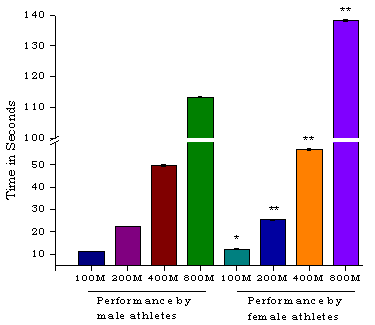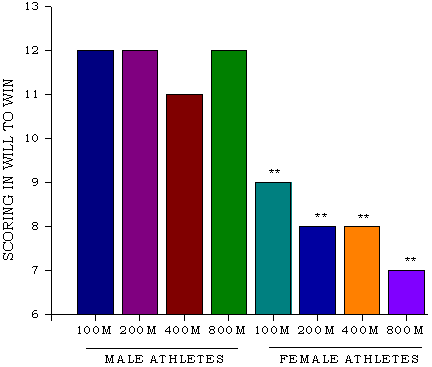-
Paper Information
- Previous Paper
- Paper Submission
-
Journal Information
- About This Journal
- Editorial Board
- Current Issue
- Archive
- Author Guidelines
- Contact Us
International Journal of Sports Science
2012; 2(4): 42-44
doi: 10.5923/j.sports.20120204.03
Performance of Male and Female Athletes at All India Inter-University Athletic Meet
Patil A. , Pasodi M S
Department of Physical Education, Gulbarga University, Gulbarga, 585 106, Karnataka, India
Correspondence to: Patil A. , Department of Physical Education, Gulbarga University, Gulbarga, 585 106, Karnataka, India.
| Email: |  |
Copyright © 2012 Scientific & Academic Publishing. All Rights Reserved.
Analyzing possible explanations for the under performance of female among the athletic events may help explain the under representation of female at the highest levels in other fields, such as tenured mathematics, science and other educational fields. The present investigation was carried out to study the differences in performance level among male and female participants in athletic events. Both male and female participants were provided with mental toughness and will to win questionnaires and scoring was done accordingly. This study from the athletic meet reveals: the overall score in performance, mental toughness and will to win concept clearly shows that the female athletes (in this particular event) lacked mental toughness and the zeal to win when compared to male athletes. This may be due to stress of competition or strain of travel since athletes traveled from different places. However with the help of coach and proper training and rigorous practice these withdraw can be converted into strength.
Keywords: Mental Toughness, Will to Win, Athletic Events, Athletes Performances, Coaches
Cite this paper: Patil A. , Pasodi M S , "Performance of Male and Female Athletes at All India Inter-University Athletic Meet", International Journal of Sports Science, Vol. 2 No. 4, 2012, pp. 42-44. doi: 10.5923/j.sports.20120204.03.
1. Introduction
- Today is an era of minimum input and maximum output and for this every potential work is being done to amplify competence. Every perspective angle is being thoroughly scrutinized by research and scientists together, so that sportsperson gets ceiling mechanical pro to improve their performances. There are studies from western countries which reveal differences in performance among male and female athletes, but such studies are rare in India.Analyzing possible explanations for the under performance of female among the athletic events may help explain the under representation of female at the highest levels in other fields, such as tenured mathematics, science and other educational fields. It has been suggested[1,2] that differences between male and female in the distribution of cognitive abilities requires for success in the field of sports partly account for the disparity (the ability-distribution-hypothesis). In particular, male and female may differ in mean performance levels, variability of performance, or both: evidence suggests that in cognitive abilities, both types of differences are found[3,4]. The general purpose of this study was to find differences in the performance of male and female athletes’ performance if any and if any differences are there then the cause for such difference in particular. At the graduation level, the students are encouraged for co-curricular activities such as drama, singing, dancing, painting, sports et cetera. It has been observed that the female students are more attracted towards singing, dancing, painting and other creative activities and comparatively less percentage of female students are attracted towards sports but in male students the situation is vice-versa. The possible reason for this may be their environment of upbringing and the level of stamina and strength required to perform the respective activities. Therefore the present investigation was carried out to study the differences in performance level among male and female participants in athletic events (100meters, 200meters, 400meters and 800meters running), who participated at All India Inter-University Athletic Meet held at Guntur, Andhra Pradesh, 2011.
2. Material and Methods
- Male and female athletes who participated for athletic events and got selected for finals and they participated in the events such as 100meters, 200meters, 400meters and 800meters running at All India Inter-University Athletic Meet held at Guntur, Andhra Pradesh, 2011 were chosen for the present study, the scores were (both males and females) noted and then sex wise comparison for their performance was done accordingly. The participants were of same age (20 ± 1 year) and had been participating in these events since four years. Both male and female participants were provided with mental toughness[5] and will to win questionnaires[6]. Sufficient time was given to all the participants to fill in the questionnaires and scoring was done accordingly. Results and Discussion: This study from the athletic meet reveals that(1) The time consumed by female athletes in 100M event was significantly (P<0.05) higher then that of male athletes. Where as the time consumed by male athletes in 200M, 400M and 800M events was significantly (P<0.01) lower then the female athletes (Table -1, Graph -1).(2) The scoring of male athletes for 200M 400M events were similar, where as this scoring increased in 100M and 800m events in male athletes. Overall the scoring for mental toughness was higher (P<0.01) in male athletes when compared to female athletes (Table – 2). The observation of scoring in female athletes for mental toughness was higher (P<0.01) in 800M event participants than in 100M, 200M and 400M respectively, indicating the need of being mentally tough in long run (Graph – 2)(3) Lastly the scoring for the concept of will to win clearly shows the difference in the will power of both the sexes (Table – 2). The scoring of all the male athletes ranged from 11 to 12 where as this scoring decreased significantly (P<0.01) in female athletes which ranged from 7 to 9 (Graph – 3). The overall score in performance, mental toughness and will to win concept clearly shows that the female athletes (in this particular event) lacked mental toughness and the zeal to win when compared to male athletes. This may be due to stress of competition or strain of travel since athletes traveled from different places.In sports, imagery and self-confidence are well-known factors that may enhance or improve athletes’ skills. Most sporting programs consist of mental practice, which has been found to help the basic development will to win in athletes at lower skill levels. Imagery is influenced by many factors including somatic anxiety, motivation, emotions, and confidence. It has been found that a factor like self-confidence is one that athletes and coaches consider as relevant for good performance. Some studies found that many people and athletes use imagery to increase exercise and physical fitness as the imagery helps the success of their exercise. There are several facts which affect the performance of athletes such as physical and psychological factors. Major among them being toughness of athletes, will to win especially while the event begins, that is the start point. Winning of an event largely depends upon the start which means half the races. The winning margin of most athletes’ races rarely exceeds a few points, so that if an athlete can gain even slight edge at the start, he has a great advantage over his opponents. Since a good start is important, it can be developed by constantly practicing the proper method on till it is mastered, and by keeping in mind that a good start is not only pick off the blocks but that will carry the sprinter to till sprinting stride in the fastest fashion[7]. The ideal starting position is on which permits the greatest amount of force to be exerted over the longest distance in the described direction in the shortest period of time[8].Various research and experiments have shown that the start is faster from the blocks. In form of individual athlete may vary in minor details, but the basic fundamentals are the same[9].[10] found that there is a high correlation between imagery and self-confidence, with males often demonstrating higher means compared to females. This finding suggests that the male athletes were more experienced and had higher levels of physical fitness, and thus used imagery during sports situations more so than females. Another study[11] revealed that the level of identified regulation, extrinsic regulation, and extrinsic motivation was significantly higher in male athletes and there is no significant difference between male and female athletes in sport motivation, but the mean sport motivation of male athletes is considerably higher. The present study also reveals that male athletes have stronger will to win and are mentally tough than female athletes.
|
3. Conclusions
- This study reveals that the female athletes’ performance in athletics is lower with respect to male athletes. Their scoring is significantly lower in mental toughness and will to win concepts, which proves that they need proper counseling and rigorous training to succeed in these athletic events. The athletes have to be mentally strong along with zeal to excel others. The institutions should conduct counseling and training for female athletes which would help improve their performance.
 | Graphs 1. Performance of male and female athletes in 100M, 200M, 400M and 800M athletic events (time consumed is converted into seconds for plotting graph) |
 | Graphs 2. Scoring of male and female athletes in Mental toughness |
 | Graphs 3. Scoring of male and female athletes in Will to Win |
References
| [1] | Pinker S (2005) Sex ed: The science of difference, The New Republic, 232, 15-17 |
| [2] | Summers LH (2005) Remarks at NBER conference on diversifying the science and engineering workforce, retrieved from www.president.harvard.edu/speeches/2005/nber.html |
| [3] | Halpern D (2000) Sex differences in cognitive abilities (3rd ed.). Mahwah NJ: Erlbaum |
| [4] | Hedges LV and Nowell A (1995) Sex differences in mental test scores, variability, and numbers of high-scoring individuals. Science, 269, 41-45 |
| [5] | Questionnaire for Mental Toughness: Dr Alan Goldberg, 226 Strong Street, Amherst, MA 01002. Competitive Advantage website www.competitiveadvantagesportsp.htm |
| [6] | Questionnaire on Will to Win by Dr. A Kumar, India |
| [7] | Luke G (1956) Coaching High School Track and Field (London : Nicholas Kaye Limited, pp. 26 |
| [8] | Maurice Sipes (1976) Hurdle Mechanics for the Female Athletes, Track Technique 65, pp. 2071. |
| [9] | Conger RM (1939) Track and Field New York, A.S. Barnesard Company, pp. 14. |
| [10] | Raweewat R et al., (2009) Evaluating the Relationship of Imagery and Self-Confidence in Female and Male Athletes, European Journal of Social Sciences – Volume 10, (1). |
| [11] | Maryam M, Abolhasan H, Abolfazl N, Yaghob B (2012) A Comparison of the Motivation of Male and Female Competitive Athletes in Golestan, Iran, Scholars Research Library Annals of Biological Research, 2012, 3 (1):31-35 |
 Abstract
Abstract Reference
Reference Full-Text PDF
Full-Text PDF Full-Text HTML
Full-Text HTML